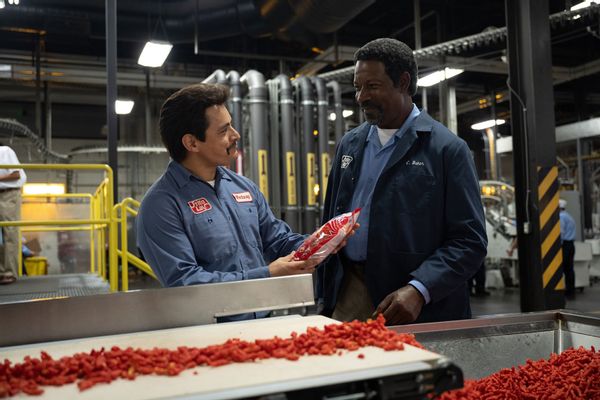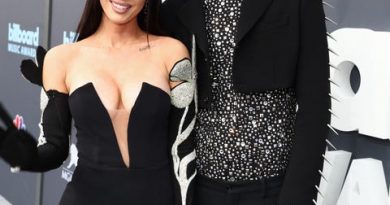“I believe him”: Jesse Garcia on playing the man who invented Flamin’ Hot Cheetos – or did he?
Jesse Garcia delivers a rousing performance as Richard Montañez, the Frito-Lay janitor who created spicy Cheetos in “Flamin’ Hot,” director Eva Longoria‘s zesty new film.
Garcia has been a hardworking actor for two decades, starring in films ranging from “Quinceañera” and “Collisions,” which he produced, to his memorable turn in the Jennifer Lopez action film “The Mother” last month. He is perfectly cast as Montañez, a man who has ambition and creates his own opportunities. Garcia also seeks opportunities, having worked behind the camera writing and directing the outstanding short, “The Price We Pay.”
Longoria’s film chronicles Montañez’s rags-to-riches story with aplomb. Richard is first seen as a child playing in the winery fields his family is working as laborers. He experiences racism and classism in school. Even when he makes an honest buck (selling burritos to classmates), he is taken for a criminal by the local police. A life of crime and drugs follows before Richard gets a janitorial job at Frito-Lay.
It is on the factory floor that Richard finds a mentor in the engineer Clarence (Dennis Haysbert) and eventually takes the initiative to call CEO Roger Enrico (Tony Shalhoub) with the idea for a spicy slurry that he thinks will boost flagging sales. (The film is set in the ’80s, during the economic downturn.) But at the heart of Richard’s ideas is catering to the underserved Hispanic market. And it is this messaging that provides the film’s inspiration.
Garcia is ingratiating as Montañez, with his chatty voiceover — Longoria has great fun with Richard voicing the Frito-Lay board meetings. Richard also earns sympathy as he struggles for respect, ably assisted by his wife, Judy (Annie Gonzalez).
The actor spoke with Salon about playing Montañez and making “Flamin’ Hot.”
Biopics are tricky because you want to represent the person but not mimic them. Did you get to talk with Richard about his life and career?
I did. I talked to him for about two hours before we started shooting. I got to go to his house, he invited me over. His wife Judy made enchiladas that I couldn’t eat because I was on a diet. [laughs] We talked about all kinds of stuff. Mostly what their lives were like. Small things that I could incorporate, like pet names and slang they used over the years. Details like that I could sprinkle throughout the movie.
Richard is proud but faces discrimination. He develops confidence, which enables him to create opportunities out of challenges. How did Richard’s story inspire you and how much of it did you identify with?
I heard about his story years ago, and I always thought it was a make a cool movie or series.
I auditioned like everyone else. Every one of my friends who were remotely right read for it.
A handful texted me and said, “You should read for it.” They said, “I want it, but I think it is your role.” I read it and I felt it was written for me; this is my part. I have to put in the work and show them there is no other choice. I grew up the same way. We didn’t have much money. My parents would sell burritos and food, and when my dad went to school, it was for auto body repair. I remember my mother would be in the kitchen making empanadas and enchiladas to sell to the other students.
When Richard is looking for work, he says he has a PhD — “poor, hungry, determined.” I feel you have the same drive as an actor, and share Richard’s thick skin and hard skull as you look for roles that are worthwhile, like this one. Can you talk about your initiative and your efforts to find and make valuable work?
This is the first time I got to play all these things in the same movie. I got to be funny, I got to play the emotional stuff, I got to do a tiny bit of action, the quiet moments, just about everything you want to do in one movie. With the action movies, heavier dramas and darker characters I’ve done, I have never been able to show my range here. I walked away from this film having done everything I wanted. I got to be funny and improvise. It was like that for everybody. Eva got to do what she wanted to do — she got her version. DeVon Franklin [the producer] was a good barometer on the outside, making sure that I wasn’t going too dark or was appropriate in certain moments. We were a good team for keeping each other in check. I’m excited to see what comes my way after people see this film and see that I can do more. I don’t mind doing five or 15 minutes in a movie, but to be in an ensemble or lead in a bigger movie like “Tron,” how cool would that be?
I’m still recovering from “The Mother.” One of your scenes was . . . painful.
It’s a pretty brutal death. People go “Oh, s**t! That was not what I was expecting!
 Jesse Garcia and Dennis Haysbert in “Flamin’ Hot” (Photo by Anna Kooris / Courtesy of Searchlight Pictures)
Jesse Garcia and Dennis Haysbert in “Flamin’ Hot” (Photo by Anna Kooris / Courtesy of Searchlight Pictures)
The point Richard makes to the Frito-Lay executives is that the Hispanic market is being underserved. You have appeared in films and TV series that play to the Latinx community. What can you say about the lack of opportunity for Latinx actors and filmmakers, the few Latinx with power to get projects made, and the need to create your own stories?
This is a great example of how a movie can transcend cultural lines. It’s a Mexican-American family, but everyone can relate to it. Eva fought for key positions in the crew — hair, makeup, cinematography with Fede[rico Cantini], and actors. When the studio and Eva were looking for actors to play Richard, she was told there are not many stars who can do this. Her response was, “Let’s create some stars.” That’s where she is a visionary and trailblazer, she excels. Little by little, it gives us the opportunity to prove ourselves and to the industry and the world that not only can we tell a story with mostly Latino cast, but that we can tell a story that is universal and it do not have to be a niche market.
You have long made films that were “issue” movies like “Quinceañera” and “Collisions,” but also have been playing in popular films like “The Mother” and the crowd-pleasing “Flamin’ Hot.” Do you see this film as a shift in your career that may turn you from the reliable character actor to leading man?
The industry is funny. I had a moment in 2006-2008 where I worked a lot and got a lot of cool projects because of “Quinceañera,” but a handful of them didn’t come out for whatever reason, because of the writers’ strike and the recession and what happened back then. “Flamin’ Hot” is a bigger and higher profile movie. It has a chance of being really successful and can reach a wide audience because of Hulu and Disney+ putting it out there. I hope that it translates to bigger projects and me having the opportunity to be in A24 films and bigger Disney films or blockbusters where it doesn’t matter if I’m Latino or not. Having the chance of playing in the same field as everybody else.
Voiceovers can often be seen as a crutch in films, but here, Richard’s narration enhances the story — especially when he has flights of fancy about how things played out. Can you talk about developing his voice? It’s the backbone of your performance. You had charisma and confidence that really holds my hand and carries me through the movie.
I did the voiceover for the entire movie five or six times. We did a temporary one during the movie so we can pace out some of the scenes. So, there is a voiceover but it’s me thinking, “How long does this have before I walk away or go talk to Clarence?” I had to record the entire film over a couple of days in Albuquerque when we were shooting. But throughout the year after filming, Eva would call me and say, “Say these 10 lines on your phone. And give me a few different ways of saying them.” It was funny to go back and find the accent, the voice. Her note was — and I’m probably giving away a trick — but I would have her ask me a question pertaining to the voiceover. “What do you think about . . . ?” I would talk to her, as if I was talking to the audience, which Is why the audience feels the message is just for them — because that is how we recorded it. Rather than giving you information, I’m telling you, Gary, this entire story, and it’s just for you. Every audience member feels like that. It was very intentional.
Want a daily wrap-up of all the news and commentary Salon has to offer? Subscribe to our morning newsletter, Crash Course.
There is a thought that what Richard did is not entirely true. What do you think?
I am letting the family give that kind of information, but I believe him.
Let’s talk food. Are you a good cook, and do you like spicy food?
I am pretty good cook. I love spice. I mix a ghost pepper sauce with honey and put that on a steak. I have been playing with different spice and sauce.
Did you have Flamin’ Hot Cheetos when they came out?
I kind of missed the Cheetos train. I grew up in Wyoming. We were behind in a lot of things. Hot Cheetos became a thing after I was out of high school, and by then I was eating super, super clean. I grew up on normal Cheetos. I missed the Flamin’ Hot. My first Flamin’ Hot was in the take in the movie where I eat a Cheeto off the production line. That was the first time I had a Flamin’ Hot Cheeto — and the last time was that day.
Are Flamin’ Hot Cheetos spicy enough for you?
It was fine. It tasted like a hot Cheeto.
I’ve never had one. After seeing “Flamin’ Hot,” though I wanted to go out and try them!
This film is going to be the biggest, best commercial for Flamin’ Hot Cheetos. The sales are going to skyrocket! We should buy stock in Flamin’ Hot Cheetos right now!
“Flamin’ Hot” is now streaming on Hulu and Disney+.
Read more
actor interviews by Gary Kramer


